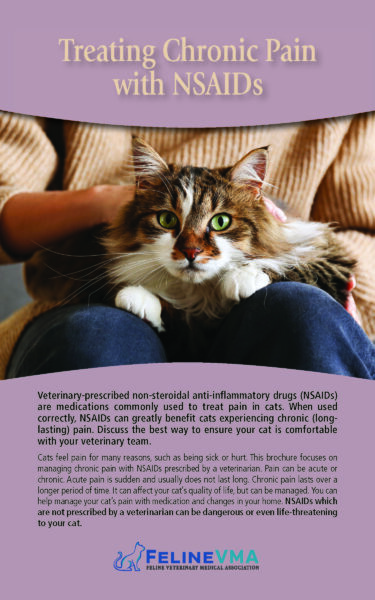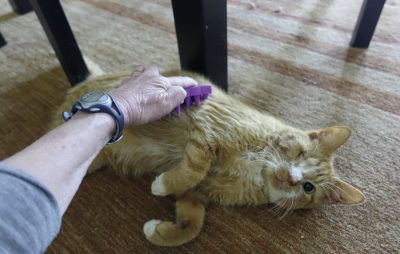Veterinary-prescribed non-steroidal anti-inflammatory drugs (NSAIDs) are medications commonly used to treat pain in cats. When used correctly, NSAIDs can greatly benefit cats experiencing chronic (longlasting) pain. Discuss the best way to ensure your cat is comfortable with your veterinary team.
Cats feel pain for many reasons, such as being sick or hurt. This article focuses on managing chronic pain with NSAIDs prescribed by a veterinarian. Pain can be acute or chronic. Acute pain is sudden and usually does not last long. Chronic pain lasts over a longer period of time. It can affect your cat’s quality of life, but can be managed. You can help manage your cat’s pain with medication and changes in your home. NSAIDs which are not prescribed by a veterinarian can be dangerous or even life-threatening to your cat.
Signs and Causes of Chronic Pain
Cats are very good at hiding pain, especially chronic pain, so you may not know anything is wrong. If you notice any of the signs of pain listed below, tell your veterinarian right away.
Signs of Pain in Cats
Signs of chronic pain in cats may not be obvious, because cats can hide pain and adjust their behavior to try to avoid discomfort. Watch for:
- Moving slowly or stiffly, especially going up and down stairs
- Limping, holding up, or not using a limb
- Reluctance or hesitation to jump up to, or down from, furniture, windowsills, etc.
- Reduced play and/or interaction with family or other pets
- Social changes, interacting less with family and pets, or interacting more
- Change in sleep, e.g., sleeping more or less than usual, or in unusual places, such as under beds
- Change in sleeping positions, being hunched up and stiff, rather than relaxed and curled up, or even sleeping/resting sitting up
- Not wanting to be stroked or brushed when previously your cat liked it
- Changes in appetite, e.g., becoming picky with food/treats
- Chewing abnormally, e.g., on one side of the mouth, swallowing food whole rather than chewing, or dropping food from their mouth
- Teeth grinding, an unpleasant scraping sound while a cat moves their mouth, sometimes when offered or trying to eat food
- Changes in litter box habits, such as going outside of the litter box, and/or defecating less frequently or with difficulty
- Grooming less, leading to a dull, rough coat or knotted/matted coat
- Twitching skin and biting or overgrooming areas of skin
- Pawing at the face or mouth, or eye twitching
The following conditions cause chronic pain: osteoarthritis; all forms of dental disease; cancer; gastrointestinal conditions affecting the stomach, intestines, or pancreas; neuropathic (nerve) pain; and bladder inflammation (cystitis). If your cat has any of these issues, talk about how to handle pain with your veterinarian.
Management of Chronic Pain
Chronic pain is best managed with medical treatment and changes in the home environment. Your veterinarian may change the type and/or amount of medication to find what works best for your cat.
How NSAIDs Manage Pain – NSAIDs are a type of pain medication that decreases painful inflammation and can be used to manage chronic pain in cats when prescribed by your veterinarian. They are given by mouth as a liquid, tablet, or capsule, and can be given at home. NSAIDs for your cat must be prescribed by your veterinarian. Many human drugs such as aspirin, ibuprofen, and paracetamol/acetaminophen can be highly toxic to cats. Do not give your cat a human drug, as it can be fatal.
When NSAIDs Might Help Long-term – Some causes of pain can be treated and the pain will end (e.g., removing a painful tooth), but other conditions are lifelong and require long-term medication to reduce discomfort (e.g., osteoarthritis). NSAIDs are commonly used for osteoarthritis, but can also be used for cancer, nerve pain, or if needed for a long period after surgery.
Taking Care of Your Cat’s Needs with Changes in the Home –When caring for your cat, providing comfort and easy access to resources is key. Here are some tips:
- You may have to move food, water, litter boxes, etc. if it is painful or difficult
 for your cat to get to them, especially if they are up or down a set of stairs.
for your cat to get to them, especially if they are up or down a set of stairs. - Your cat needs 1–2 safe spaces in their favorite area(s) for resting and sleeping with sides that allow them to feel hidden and safe. Many cats like safe spaces that are high up so your cat might need pet steps or a ramp to reach these.
- Your cat needs food, water, litter boxes, resting and sleeping areas, and a place to scratch. Put litter boxes where your cat spends the most time, and away from noise, other pets, and food/water bowls. If your cat has trouble getting into and out of a litter box, look for a box that has one side lower than the others. Your cat’s scratching post needs might change; if your cat cannot scratch using a vertical post, try a horizontal one.
- If your cat wants, you can play with them at least twice a day. They may not pounce on a wand toy, but they might like to watch it move and may only play for a few minutes.
- Cats prefer to have all four paws on the floor, so only pick up your cat gently if it is a normal part of your routine and your cat is asking to be picked up. If you need to move your cat, do it while they are in a cat bed, or loosely wrap a towel or blanket around them.

- If your cat is not grooming themselves well, try using a soft brush or grooming glove. Avoid all brushing in areas that your cat reacts to and finds painful. Don’t pull out mats. Large mats may need to be groomed professionally so speak to your veterinarian first. Scissors can cut skin and should not be used to trim hair.
How To Give NSAIDs to Your Cat
When NSAIDs are used at home, they are given orally — directly into the cat’s mouth. It is important to give the correct dose, which is based on a cat’s body weight. Your veterinarian can show you how to get the right amount of liquid NSAIDs into a syringe, how many tablets or parts of a tablet to use, and how frequently (usually once a day).
Try to give NSAIDs at the same time every day. Medicating cats is not always easy, but most NSAIDs can (and should) be given with food or a treat. (You do not want your cat to stop eating their regular food. If that starts to happen, immediately stop putting any medication in the food and talk to your veterinarian.) You can use liquid treats for giving liquid NSAIDs. If you have tablets, you can put them into soft, moldable treats. Contact your veterinarian if you have questions about the dose, how to give the medication, or if you are having trouble giving your cat the medicine. Combining NSAIDs with some other medications and/or supplements can have side effects, so tell your veterinarian about everything your cat is taking.
Download Flyer – Tips for Medicating a Cat
Caring for a Cat on NSAIDs
Cats on NSAIDs must eat and drink well to avoid side effects. If your cat is not eating normally or drinking enough, talk to your veterinarian before giving any more medicine. Give your cat many options for water such as water fountains, wide ceramic bowls, or dripping faucets to encourage cats to drink and help avoid dehydration. Ask your veterinarian for other ways to increase water intake such as adding warm water or tuna juice to your cat’s food.
Watch for signs of illness, such as vomiting, diarrhea, drinking more, or lethargy. Any medication can cause side effects, including NSAIDs (e.g., decreased appetite or not eating, blood in feces, vomiting). If you notice any of these changes, call your veterinarian right away before giving the next dose. Giving the right dose is important, so if you think your cat has lost or gained weight, the dose may need to be adjusted. Ask for your cat to be weighed at your next appointment or weigh them at home using an infant scale. Your veterinarian may also recommend more frequent visits and bloodwork to monitor your cat while taking an NSAID.
It might be hard to see if the NSAIDs are making a difference because cats show pain in subtle ways. If your cat is being treated for osteoarthritis, you can take a mobility questionnaire before and after NSAID treatment, send videos of your cat moving around for your veterinarian to review, and look for signs that your cat is getting better.



 for your cat to get to them, especially if they are up or down a set of stairs.
for your cat to get to them, especially if they are up or down a set of stairs.